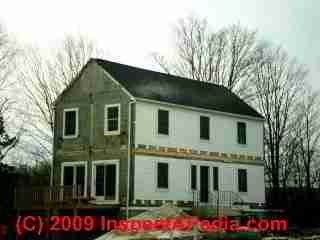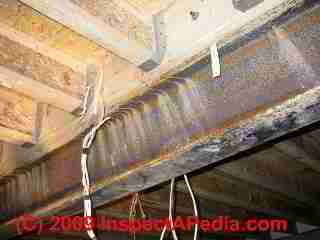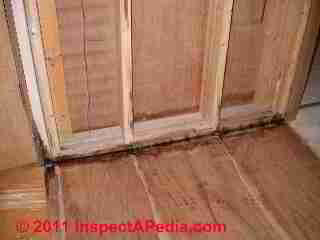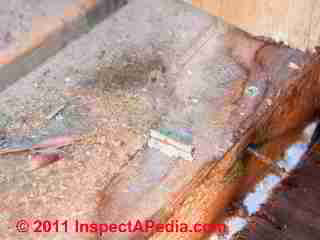 Mold Contamination in New Modular Homes
Mold Contamination in New Modular Homes
Case report: finding hidden mold in modular construction
- POST a QUESTION or COMMENT about hidden mold contamination in modular-constructed buildings
Mold contamination in modular constructed homes:
This article describes instances of problematic or harmful mold contamination found hidden in walls, flooring, and even cabinets of a modular home that traveled in rain without adequate seal-protection against water entry. Other cases of mold concerns or mold contamination in modular homes are included.
A look at why we suspected that there was hidden mold contamination in the home and how the extent of mold contamination was determined can assist in investigating any building for hidden mold problems.
InspectAPedia tolerates no conflicts of interest. We have no relationship with advertisers, products, or services discussed at this website.
- Daniel Friedman, Publisher/Editor/Author - See WHO ARE WE?
Mold in Modular Homes
Mold may be found in surprising locations in modular homes depending on the home's delivery conditions and construction history.
Residential modular home structures include cavities between floors and some walls that an inexperienced inspector may fail to consider. Knowing that water had entered this modular structure we obtained permission for some destructive inspecting that helped track how water had moved through the building.
Field Report of Extensive Hidden Mold in a Modular Home: Mrs . X (Sick of mold)
 Mrs. X (Sick of mold) , living for a year in a modular home constructed new for herself and her husband in Newburgh, New York, developed severe mold-related illness. Ultimately she had to travel in her pajamas and by ambulance to a local hospital where she was admitted and treated for more than a month.
Mrs. X (Sick of mold) , living for a year in a modular home constructed new for herself and her husband in Newburgh, New York, developed severe mold-related illness. Ultimately she had to travel in her pajamas and by ambulance to a local hospital where she was admitted and treated for more than a month.
Feeling better and about to be discharged, Mrs. X (Sick of mold) asked Mr. X (Worried) to bring her a clean outfit from home so that she could return home in something nicer than her pajamas X (Worried) stopped by their home that to him looked and smelled clean, if a bit lonely.
He selected a full outfit from a closet used by Mrs. X (Sick of mold) .
When in the hospital Mrs. X (Sick of mold) opened the suitcase of clean clothes she went immediately into anaphylactic shock, scaring everyone, especially Mr. X (Worried) and extending her hospital stay by another week.
A suspicion reared its moldy head: maybe there was something moldy about the clothing that mold-sensitive Mrs. X (Sick of mold) had taken out of the suitcase.
The owners asked me [DF] to investigate.
I [DF] was engaged to inspect the home and was given permission to perform invasive inspection as needed to find possible mold contamination in the building.
 The house looked new and clean. But in the basement it was curious to see mud splashed up against the under-side of the home. Curious but not unusual. But then I saw what looked like water marks on the mating beams and at the sill plates.
The house looked new and clean. But in the basement it was curious to see mud splashed up against the under-side of the home. Curious but not unusual. But then I saw what looked like water marks on the mating beams and at the sill plates.
Notice that there is no housewrap and no siding on the gable ends of the four sections making up this modular home.
[Click to enlarge any image]
Moving back upstairs I lifted back the wall to wall carpets at their corners. Water stains and a bit of mold were plain to see.
Based on what I saw there, made some test cuts along the bottom of walls around all sides of the main floor of the home.
In wall cavities at all of the exterior walls near floor level and even in the marriage wall cavities I found very extensive mold contamination.
Also see MOLD APPEARANCE on VARIOUS SURFACES
I also found extensive mold contamination in the building's fiberglass insulation in all of its exterior walls. Attic insulation was mold-free and did not appear to have ever been wet.
See details at FIBERGLASS INSULATION MOLD
On reviewing the construction history I learned that the home had been delivered and set in rainy weather. The owners also told me that they had observed wet carpets and water in kitchen cabinets at the time the home was delivered and set but as no one saw any mold no one thought further about that wetting event.
 The modular home section shown at left was being transported with adequate weather protection.
The modular home section shown at left was being transported with adequate weather protection.
But a review of the owner's photographs of the modular home sections arriving at the site we could see that the front ends of the modular home segments had been shipped from the factory without the usual careful plastic wrap to protect the un-finished side of the home from the weather.
Driving a modular home up New York's I84 in rain at 65 mph or more forced water into the building's wall and floor cavities and into portions of the interior, as well as forcing water into the party or marry walls of the structure from whence it had entered kitchen cabinets.
The home would have required a gut-renovation to remove all of the moldy drywall and insulation.
The manufacturer elected to replace the unit with a clean, dry one.
...
Reader Comments, Questions & Answers About The Article Above
Below you will find questions and answers previously posted on this page at its page bottom reader comment box.
Reader Q&A - also see RECOMMENDED ARTICLES & FAQs
On 2018-04-18 - by (mod) -
first permit me to clarify a couple of basic points. If you see mold contamination in your home, with a few exceptions, you don't need to test it, you need to remove it and fix the cause for its growth.what you need now is a scope of work defined by competent building inspector who's familiar with mold contamination clean up. That is an inspector needs to make a first guess at what needs to be removed or cleaned as well as what leak repairs are needed.
Black mold is a mis-focus. Mold of any color growing on indoor surfaces can be harmful and needs to be removed
On 2018-04-18 by Kelly
Need some help. We are at a loss for what to do. Long story short, we have been living in a 1988 manufactured home for almost 3 years now. As with all older homes the water heater needed to be replaced. So we decided to go ahead and start making some other improvements while replacing the water heater.
When we took down the wall around the water heater we found black mold that also continued into the bathroom, ceiling and floor. We had a professional come out to test the mold. They did a controlled air sample outside as well as two different tests inside.
We got the results only to find out that we have toxic black mold in Medium to high levels. Next we reached out to our insurance company, which said they cannot do anything to help do to the mold being a "pre-existing condition" (something that had been there longer than our three years of living there). Now we have a house that we can't live in and no clue where to go from here?
On 2016-04-14 - by (mod) -
Thanks for the follow-up, Janelle.Even if a modular manufacturer installed soaking wet OSB on a home in August, in normal construction the exterior air barrier on the home and the exterior siding are not a waterproof membrane. In fact they are designed to let moisture out while keeping rain against the wall from leaking in. So eight months after original construction (April of the next year), the wall cavities and OSB might at most be damp, but not soaking wet.
In sum, even if wet OSB was installed originally, or got soaked during delivery (driving an unprotected home through a downpour enroute to the site), it ought not be soaking wet now. So while I cannot see your house nearly as well as an on-site expert, I would certainly wish that the inspection would consider other defects in construction, such as improperly installed siding and housewrap that let water into the walls, roof leaks into walls, plumbing leaks into walls, or some other problem.
You indeed need a complete, and very credible, documented report on the home's conditions, their causes and their remedies in order to
1. know what repair work is needed
2. the causes and thus the responsibility of the problem
On 2016-04-14 by Janelle
Thank you for your advice. We had an inspector come out and he feels it's bad material. He doesn't see any leakage causing the high moisture level. He feels the modular factory used damp material and it never dried. We also found mold behind the OSB on the outside of the house. So now there's mold in the floor cavity of attic and behind OSB on outside of the house. My husband and I are so disgusted after the money we spent on our house and it's less then a year old. The modular company is dragging their feet on replacing all the OSB. But we're insisting that they do and all new siding because the warped OSB caused the siding to become wavey. It's a huge mess!
On 2016-04-12 - by (mod) -
Janelle,Thank you for the field report and gee, I'm sorry to read you may have a similar issue. 66% moisture in wood sheathing of any sort is essentially ... wet.
You need to find the points of leakage in order to understand where to look further into wall or ceiling cavities. Ultimately you need a complete remediation plan for the home that tells you what demolition, cleaning, and repair are required.
I wouldn't waste time on "mold tests" - what's needed is a thorough diagnostic inspection by an indepenent expert with complete photo and written documentation of conditions in the home: wet, modly, cause, cleaning needed, repairs needed.
On 2016-04-12 by Janelle
The first story on your page is very similar to ours but we're in the middle of it now. We have been in our cape cod modular since August of 2015. I started noticing a mold/mildew smell coming from our pocket door in master bathroom. We discovered mold between the cavity of Attic floor and downstairs ceiling.
The entire cavity of our home has mold. We also are experiencing our siding and OSB on the outside of house is buckling and wavey. We had an inspector out and he tested the moisture level of OSB on outside of house and its 66%. He said that's really bad and should only be 8-12%. He's afraid we could have mold behind OSB on the outside of our home.
We are so upset because our house is less then a year old and we want this all taken care of correctly. We have a year warranty but the factory doesn't seem totally willing to take care of all that we're asking. Any advice in this matter would be greatly appreciated. Thanks
On 2015-09-15 by Cindy
I have black toxic nooks in my a/c unit. Do you have a picture of what this might look like?
Reader Question: mold in 2005 modular home
(Sept 12, 2014) Dan said:
We bought a used 1995 modular home in 2005 that consists of one middle pod (10 ft ceilings) and two side pods (8 foot ceilings). The roof line is 4/12 pitch. When you enter the attic space up to the middle pod (which is overlaid with metal sheeting) you can see all the way to the other end.
However, in order to get from the middle pod to the side pods, you have to crawl through a small opening that was cut out by one of the workers. Everywhere else there is a wall of plywood that separates the lower section (side pods) from the upper (middle pod). I did not think much of it until we found out that the lower sections now have mold growing on the underside of the plywood for the roof.
A mold inspector told us that this plywood was preventing air from circulating. In short, he said that the eave vents have no way of circulating air with the middle pod's roof vents. My question: What is the purpose of the plywood? Should it have been removed?
During this discovery, we found out that a sewer vent, and two other air vents were never vented out through the roof. In other words, the vents were exhausting warm air into the attic. The mold inspector commented that the combination of these two failures brought on the mold which is now making my family sick. 2nd question: What can I do about this huge problem we now face?
This question appeared originally
Reply:
Dan
What a mess. Under a 4/12 roof the accessible area under the lower slopes is very limited - too limited to think about adequate cleaning & insulation replacement from inside the attic space.
That leaves two approaches: tear off all of the roof, remove all insulation, clean and seal all surfaces, re-insulate, re-roof,
or
Tear down ceilings indoors and do the same job from inside.
The second approach is more disruptive to the occupied interior and increases the risk of cross contamination and thus the need for still more indoor HEPA vacuum cleaning and wiping.
Normally I oppose heroic, expensive roof tear offs to address attic mold as not being justified. But I would not want to leave a large problematic mold reservoir in a building: indeed air movement can move "backwards" down into a structure in some conditions.
I would first do some careful sampling of the molds present: on plywood, in insulation (by vacuum testing) and on the attic side of ceiling drywall. If none of the molds found are highly mobile - highly harmful (e.g. if it's just some simple Cladosporium) I might do nothing except fix the venting. Otherwise, I'd consider the remediation I outlined above.
The plywood was doubtless in place to enclose and protect the structure during transport.
Leaving it in place indeed blocks the proper roof ventilation.
Failure to vent plumbing vents to outdoors is a site set-crew SNAFU which is another example of why modular companies often want their own crews to set the house. Modulars encourage construction by builders who don't know enough about building.
Tell me the state where you are located and the brand and model of your home and I can research this further.
Kudos to your home inspector.
...
Continue reading at HIDDEN MOLD, HOW TO FIND or select a topic from the closely-related articles below, or see the complete ARTICLE INDEX.
Or see these
Recommended Articles
- MOLD ACTION GUIDE - WHAT TO DO ABOUT MOLD
- MOLD GROWTH on SURFACES, TABLE OF
- MODULAR HOME CONSTRUCTION
- MOBILE & MODULAR HOME MOLD
- MOBILE HOME MOLD CONTAMINATION
Suggested citation for this web page
MODULAR HOME MOLD CONTAMINATION at InspectApedia.com - online encyclopedia of building & environmental inspection, testing, diagnosis, repair, & problem prevention advice.
Or see this
INDEX to RELATED ARTICLES: ARTICLE INDEX to MOLD CONTAMINATION & REMEDIATION
Or use the SEARCH BOX found below to Ask a Question or Search InspectApedia
Ask a Question or Search InspectApedia
Try the search box just below, or if you prefer, post a question or comment in the Comments box below and we will respond promptly.
Search the InspectApedia website
Note: appearance of your Comment below may be delayed: if your comment contains an image, photograph, web link, or text that looks to the software as if it might be a web link, your posting will appear after it has been approved by a moderator. Apologies for the delay.
Only one image can be added per comment but you can post as many comments, and therefore images, as you like.
You will not receive a notification when a response to your question has been posted.
Please bookmark this page to make it easy for you to check back for our response.
IF above you see "Comment Form is loading comments..." then COMMENT BOX - countable.ca / bawkbox.com IS NOT WORKING.
In any case you are welcome to send an email directly to us at InspectApedia.com at editor@inspectApedia.com
We'll reply to you directly. Please help us help you by noting, in your email, the URL of the InspectApedia page where you wanted to comment.
Citations & References
In addition to any citations in the article above, a full list is available on request.
- [5] "Modular Home Construction, special defects and inspection methods" Dan Friedman, NY Metro ASHI Seminar, Holiday Inn, Crowne Plaza, White Plains NY, October 4, 1996
- In addition to citations & references found in this article, see the research citations given at the end of the related articles found at our suggested
CONTINUE READING or RECOMMENDED ARTICLES.
- Carson, Dunlop & Associates Ltd., 120 Carlton Street Suite 407, Toronto ON M5A 4K2. Tel: (416) 964-9415 1-800-268-7070 Email: info@carsondunlop.com. Alan Carson is a past president of ASHI, the American Society of Home Inspectors.
Thanks to Alan Carson and Bob Dunlop, for permission for InspectAPedia to use text excerpts from The HOME REFERENCE BOOK - the Encyclopedia of Homes and to use illustrations from The ILLUSTRATED HOME .
Carson Dunlop Associates provides extensive home inspection education and report writing material. In gratitude we provide links to tsome Carson Dunlop Associates products and services.



